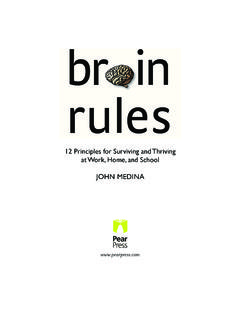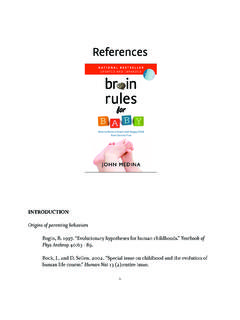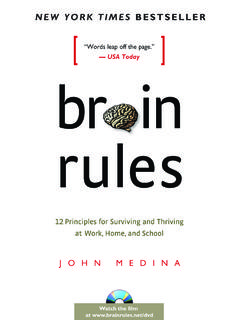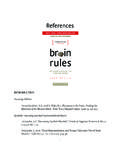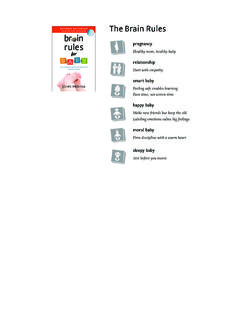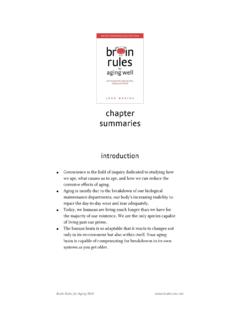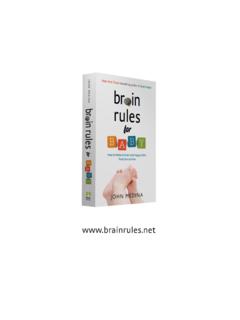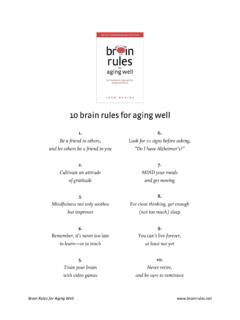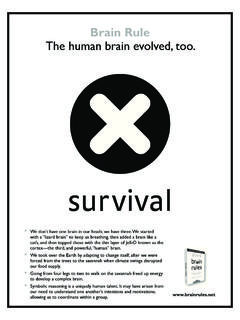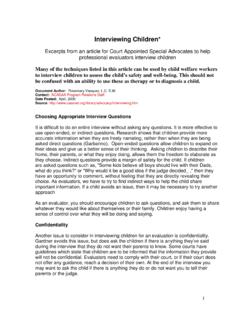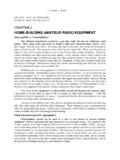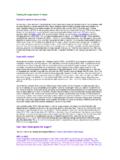Transcription of Brain Rules - Introduction - by John Medina
1 1. INTRODUCTION1go ahead and multiply the number 8,388,628 x 2 in your head. Can you do it in a few seconds? There is a young man who can double that number 24 times in the space of a few seconds. He gets it right every time. There is a boy who can tell you the precise time of day at any moment, even in his sleep. There is a girl who can cor-rectly determine the exact dimensions of an object 20 feet away. There is a child who at age 6 drew such vivid and complex pictures, some people ranked her version of a galloping horse over one drawn by da Vinci. Yet none of these children have an IQ greater than Brain is an amazing thing. Your Brain may not be nearly so odd, but it is no less extraordi-nary. Easily the most sophisticated information-transfer system on Earth, your Brain is fully capable of taking the little black squiggles in this book and deriving meaning from them.
2 To accomplish this mir-acle, your Brain sends jolts of electricity crackling through hundreds of miles of wires composed of Brain cells so small that thousands of them could fit into the period at the end of this sentence. You accomplish IntroductionBRAIN RULES2all of this in less time than it takes you to blink. Indeed, you have just done it. What s equally incredible, given our intimate association with it, is this: Most of us have no idea how our Brain works. 12 Brain RulesMy goal is to introduce you to 12 things we know about how the Brain works. I call these Brain Rules . For each rule, I present the sci-ence, introduce you to the researchers behind it, and then offer ideas for how the rule might apply to our daily lives, especially at work and school. The Brain is complex, and I am taking only slivers of informa-tion from each subject not comprehensive but, I hope, accessible.
3 Here is a sampling of the ideas you ll encounter: We are not used to sitting at a desk for eight hours a day. From an evolutionary perspective, our brains developed while we walked or ran as many as 12 miles a day. The Brain still craves this experi-ence. That s why exercise boosts Brain power ( Brain Rule #2) in sedentary populations like our own. Exercisers outperform couch potatoes in long-term memory, reasoning, attention, and problem-solving tasks. As you no doubt have noticed if you ve ever sat through a typ-ical PowerPoint presentation, people don t pay attention to boring things ( Brain Rule #6). You ve got seconds to grab someone s atten-tion and only 10 minutes to keep it. At 9 minutes and 59 seconds, you must do something to regain attention and restart the clock something emotional and relevant.
4 Also, the Brain needs a break. That s why I use stories in this book to make many of my points. Ever feel tired about three o clock in the afternoon? That s because your Brain really wants to take a nap. You might be more productive if you did. In one study, a 26-minute nap improved NASA pilots performance by 34 percent. And whether you get enough rest at night affects your mental agility the next day. Sleep well, think well ( Brain Rule #3).1. INTRODUCTION3 We ll meet a man who can remember everything he reads after seeing the words just once. Most of us do more forgetting than remembering, of course, and that s why we must repeat to remember ( Brain Rule #7). When you understand the Brain s Rules for memory, you ll see why I want to destroy the notion of homework. We ll find out why the terrible twos only look like active rebel-lion but actually are a child s powerful urge to explore.
5 Babies may not have a lot of knowledge about the world, but they know a whole lot about how to get it. We are powerful and natural explorers ( Brain Rule #12). This never leaves us, despite the artificial environments we ve built for grump factorI am a nice guy, but I am a grumpy scientist. For a study to appear in this book, it has to pass what some of my clients call MGF: the Medina Grump Factor. That means the supporting research for each of my points must first be published in a peer-reviewed journal and then successfully replicated. Many of the studies have been replicated dozens of times. (To stay as reader-friendly as pos-sible, extensive references are not in this book but can be found at )No prescriptionsThere s a great deal we don t know about the Brain . I am a develop-mental molecular biologist specializing in psychiatric disorders.
6 I have been a private consultant for most of my professional life, working on countless research projects beyond the lab bench. Over and over in my career, I have seen what a distance there is between a gene (one s DNA instructions) and a behavior (how a person actually acts). It s very hard to say with certainty that a specific behavior is caused by a specific gene, or that changing X behavior will produce Y result. Occasionally, I would run across articles and books that made startling claims based on recent advances in Brain science about Brain RULES4how we should teach people and do business. The Mozart Effect comes to mind: the popular idea that listening to classical music makes students better at math. Or the notion that analytical people are left Brain people and creative people are right Brain people, and each must be managed accordingly.
7 Sometimes I would panic, wondering if the authors were reading some literature totally off my radar screen. I speak several dialects of Brain science, and I knew nothing from those worlds capable of dictating best practices for education and business. In truth, if we ever fully understood how the human Brain knew how to pick up a glass of water, it would repre-sent a major achievement. There was no need for me to panic. Brain research still cannot without equivocation tell us how to become better teachers, parents, business leaders, or students. In addition to the ideas you ll find within each chapter, I end each chapter a few more potential ways to apply the research in our daily lives. But these are not prescriptions. They are hypotheses. If you try them, you will be doing your own little research project to see whether they work for to the jungleWhat we know about the Brain comes from biologists who study Brain tissues, experimental psychologists who study behavior, cog-nitive neuroscientists who study how the first relates to the second, and evolutionary biologists.
8 Though we know precious little about how the Brain works, our evolutionary history tells us this: The Brain appears to be designed to (1) solve problems (2) related to surviving (3) in an unstable outdoor environment, and (4) to do so in nearly constant motion. I call this the Brain s performance envelope. Each subject in this book exercise, sleep, stress, wiring, atten-tion, memory, sensory integration, vision, music, gender, and exploration relates to this performance envelope. We were in motion, getting lots of exercise. Environmental instability led to the extremely flexible way our brains are wired, allowing us to solve 1. INTRODUCTION5problems through exploration. To survive in the great outdoors, we needed to learn from our mistakes. That meant paying attention to certain things at the expense of others, and it meant creating mem-ories in a particular way.
9 Though we have been stuffing them into classrooms and cubicles for decades, our brains actually were built to survive in jungles and grasslands. We have not outgrown we don t fully understand how our brains work, we do dumb things. We try to talk on our cell phones and drive at the same time, even though it is literally impossible for our brains to multi-task when it comes to paying attention. We have created high-stress office environments, even though a stressed Brain is significantly less productive than a non-stressed Brain . Our schools are designed so that most real learning has to occur at home. Taken together, what do the studies in this book show? Mostly this: If you wanted to create an education environment that was directly opposed to what the Brain was good at doing, you probably would design something like a classroom.
10 If you wanted to create a business environment that was directly opposed to what the Brain was good at doing, you prob-ably would design something like a cubicle. And if you wanted to change things, you might have to tear down both and start over. Blame it on the fact that Brain scientists rarely have a conversa-tion with teachers and business professionals, education majors and accountants, superintendents and CEOs. Unless you have the Journal of Neuroscience sitting on your coffee table, you re out of the book is meant to get you into the : Why your Brain is so amazingBrain Rule #1: The human Brain evolved, tooWhen he was 4, my son Noah picked up a stick in our backyard and showed it to me. Nice stick you have there, young fellow, I said. He replied earnestly, That s not a stick. That s a sword! Stick em up! I raised my hands to the air. We both laughed.
